
Okhotsk Chapter
of the Wild Bird Society of Japan
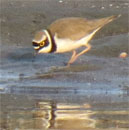
| Home | Events | Reports | Sightings | Checklist | Bird Guide |
| Birding Info | J Bird Names | References | Links | About Us | Contact Us |
The Sightings page relates unusual sightings in this region. The primary source of information for these sightings is the blog on the Okhotsk Chapter's main site. "OSJ" refers to the Ornithological Society of Japan, and 2012 and 2024 refer to the 7th and 8th editions of their Check-list of Japanese Birds, respectively. Status abbreviations apearing below are AV: Accidental Visitor; IV: Irregular Visitor; PV: Passage Visitor; WV: Winter Visitor; MB: Migrant Breeder; RB: Resident Breeder (OSJ 2024).
.jpg) |
Buller's Shearwater (Minami-onaga-mizunagidori; Ardenna bulleri) 7 October 2010, Offshore from Komuke Lake area, The first record of a Buller's Shearwater in the Okhotsk region occurred on 5 September 2008 northwest of Cape Shiretoko in the Sea of Okhotsk, as reported by Kouta Kurasawa and Hal Sato in issue #31 (2010) of the Bulletin of the Shiretoko Museum (Kenkyuu Houkoku). The photo at left of a Buller's shearwater was taken by Tetchan-san on 7 October 2010 offshore from Komuke Lake, and on this same day, 6+ Buller's shearwaters were sighted during an Abashiri Nature Cruise by four members of the Okhotsk Chapter. One more sighting was recorded by Nabeyoshi-san on 11 November 2012 offshore from the Oshinkoshin Waterfall on the north side of the Shiretoko Peninsula. No sightings have been recorded in the Okhotsk area since then (as of April 2025). Buller's shearwater breeds on islands off the north island of New Zealand with sightings in Japan occurring mainly off the east coast of Honshu (south of Hokkaido) in August through October. Its status in the Sea of Okhotsk is given as AV. (from OSJ, 2024). |
.jpg) |
Stellar's Eider (juv) (Ko-kewata-gamo; Polysticta stelleri) 3 January 2012, Mombetsu port, First record of a Stellar's eider in the Okhotsk region. Reported by Yuki-san. Found mixed in a group of greater scaups (suzu-gamo). According to OSJ (2024): The Stellar's eider breeds on the coast of Siberia from Novaya Zemlya to the Chukot Peninsula, St. Lawrence I., and Alaskan coasts; and winters to the coast of Lapland, Baltic Sea, Kamchatka, Aleutian Is., and Alaskan Peninsula. Status is given as AV in n Hokkaido, IV in e and c Hokkaido, and WV in the southern Kuriles; it is AV at two locations in Honshu. |
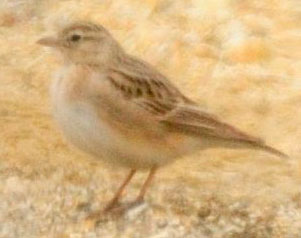 |
Greater Short-toed Lark (Hime-koutenshi; Calandrella brachydactyla) 5 May 2013, Shibunotsunai Lake (east of Komuke Lake), Found and photographed by Kaito-san. This is the first time for this bird to be found in the Okhotsk region, though not a first for Hokkaido, and it has been added to the Checklist. Its status in Hokkaido is given as Accidental Visitor by the OSJ, and is indeed AV in the rest of Japan as well. According to OSJ (2012) this bird in Japan is a subspecies, C. b. longipennis, that "Breeds from the Ukraine, n Caucasus, Iran to Transbaikalia and Manchuria. Winters mainly to Afghanistan, Pakistan, and nw India; casual in Sakhalin, Korea, and Japan." Brazil (2009): "Habitat & habits: Open steppe with sparse vegetation; visits agricultural fields." |
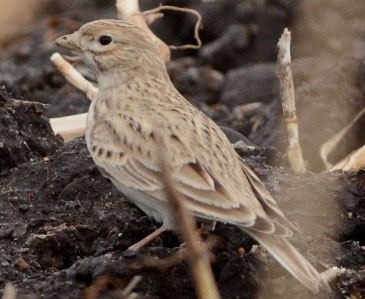 |
Asian Short-toed Lark (Ko-hibari; Calandrella cheleensis) 28 November 2013, Hama-koshimizu area, Found and photographed by Kanrinin-san. It is remarkable that two different short-toed larks, both sighted for the first time in the Okhotsk region of Hokkaido, were sighted within just a few months of each other. Its status in Hokkaido is given as Accidental Visitor by the OSJ (2012), same as the Greater Short-toed Lark, and is AV in the rest of Japan as well. According to OSJ, this bird in Japan is a subspecies, C. c. cheleensis, that "Breeds in ne Mongolia, Transbaikalia, and Manchuria. Winters to s Manchuria and n China; casual in Japan." Brazil (2009): "Habitat & habits: Dry steppe or dry agricultural land." |
.jpg) |
Black-footed Albatross (Kuro-ashi Ahoudori; Phoebastria nigripes) 10 October 2013, Abashiri, First record of an albatross in the Okhotsk region. Sighting and photo by Masayuki Miyamoto, during a seabirding cruise aboard the Chipashiri. A black-footed albatross has been sighted fairly regularly during cruises from 2022 (as of autumn 2024), but no sightings have been recorded between 2014 and 2021. According to OSJ (2024): It's range is oceanic in the n and c Pacific north to the Kuril Is. and Gulf of Alaska, east to the California coast and west to Japanese waters. It breeds on the Hawaiian Is., Ogasawara Is., Torishima I., and Senkaku Is. Its status is given as IV in Hokkaido, southern Kuriles, Honshu, and Shikoku, but has a more frequent presence on and around many of the smaller islands around Japan. |
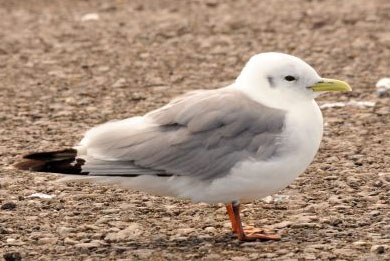 |
Black-legged Kittiwake (Mitsuyubi-kamome; Rissa tridactyla) 27 October 2013, Garinko port area in Mombetsu, Sighted and photographed by Kaito-san. Since the bird in this photo has reddish legs, there was a debate about whether it was a Red-legged Kittiwake or a Black-legged one. According to Kanrinin, compared to the Red-legged, this one has "longer legs, longer bill, gentler-sloping forehead, smaller-looking eyes, paler grey upper wings, and it is thus a Black-legged Kittiwake." Both Brazil (2009) and "The Wild Birds of Hokkaido" (2012; of which Kanrinin is one of the authors) convey that individuals with "orange-red" legs are rare but do exist. This bird in Hokkaido is a subspecies, R. t. pollicaris, that is a Winter Visitor (OSJ, 2012) and also called a Pacific Kittiwake (Brazil, 2009). Red-legged kittiwakes are rare in the Okhotsk region but have been sighted; IV in e and AV in n Hokkaido (OSJ 2024). |
 |
Large numbers of Eurasian Coots (Oo-ban; Fulica atra) 30 Nov, 4-5 Dec 2014; Abashiri Lake at Memanbetsu Reports on the Okhotsk Chapter blog: 30 November: 157 (count and photo by Kanrinin) 4 December: 304 (by Hanada-san) 5 December: 254 (by Hanada-san) 10 December: 0 (by Hanada-san) Don't know about years before the 1970s, but coots have been very rare in the Okhotsk region, typically one or two at Tofutsu Lake. In 2013, up to 13 were counted during the weeks prior to the onset of freezing at Heiwa Bridge, Tofutsu Lake. This we thought was a lot. In late November 2014, there were 5 or so coots at Heiwa Bridge. |
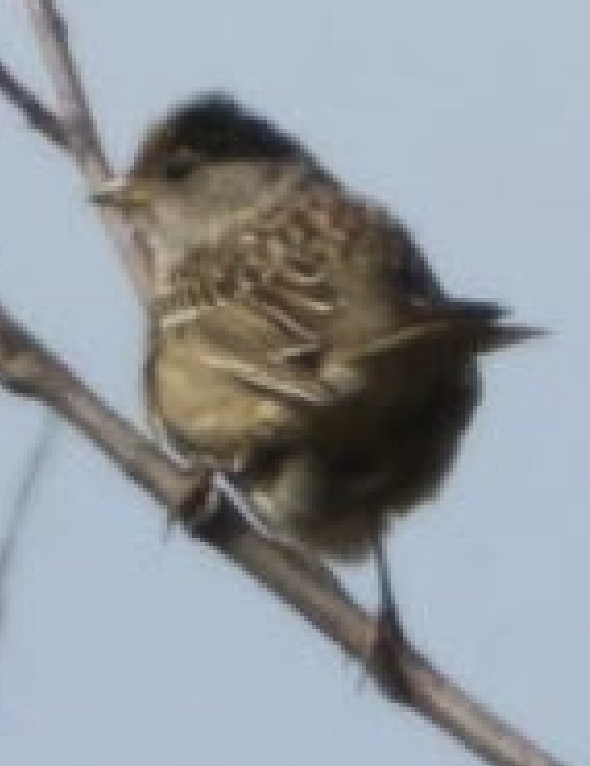  |
Golden-crowned Sparrow (Kigashira-shitodo; Zonotrichia atricapilla) 18-21 April 2019, Okoppe, First record of a golden-crowned sparrow in the Okhotsk region. Reported by Tetchan-san. Monotypic. According to OSJ (2024): The golden-crowned sparrow breeds in w North America east of the Rockies from Alaska south to British Columbia and n Washington, and winters in the west coast of US south to Baja California and nw Mexico; straggles to Japan. Status is given as AV in Hokkaido and several other parts of Japan where sightings have been recorded. |
.jpg) |
Common Chiffchaff (Chifuchafu; Phylloscopus collybita) 2 May 2019, Hama-koshimizu, First record of a chiffchaff in the Okhotsk region. Reported by Kanrinin-san. According to OSJ (2024): The chiffchaff sighted in Japan is the subspecies P. c. tristis, which breeds in se Siberia from the upper Yenisei to Lake Baikal, north to the upper Kolyma, n Kazakstan, nw China, nw Mongolia, and winters to the Himalayan region, c India, Bengal, s Iraq and s Iran; casual in Japan. Status is given as AV in Hokkaido and numerous other parts of Japan, except Hegurajima Is and Tobishima Is, both facing the Sea of Japan, where it is IV and PV, respectively. |
  |
Lesser Whitethroat (Ko-nodojiro-mushikui; Curruca curruca) Daily 21-31 December 2019, Yamubetsu, Koshimizu, First record of a Lesser Whitethroat in the Okhotsk region. Reported by Ittetsu-san. According to OSJ (2024): The lesser whitethroat sighted in Japan is an unidentified subspecies; the species breeds from the British Isles, e and s Scandinavia, eastward through e Europe to Transbaikalia, south to the Balkans, Asia Minor, w Iran, the Caucasus, s Siberia, and Mongolia, and winters to c Africa, s Arabian Peninsula, n India, and sw Asia. Status of the subspecies is given as AV in Hokkaido and numerous other parts of Japan except Tobishima Is., facing the Sea of Japan, where it is PV. |
det.jpg) det.jpg) |
Oriental Dollarbird (Buppousou; Eurystomus orientalis) 30 June 2020, Nishi-okoppe, First record of an Oriental dollarbird in the Okhotsk region. Reported by Tetchan-san. According to OSJ (2024): The Oriental dollarbird sighted in Japan is the subspecies E. o. cyanocollis, which breeds from the Himalayas east through Assam to China, Amur Basin, Korea, and Japan. Winters to India, se Asia, and Sumatra. Status is given as IV in Hokkaido and as AV, IV, PV, or WV in numerous other parts of Japan, as well as MB in Shikoku and Kyushu. |
det.jpg) |
Pallas's Reed Bunting (Shiberia Jurin; Emberiza pallasi) 12 January 2022, Cape Notoro, Abashiri, First record of a Pallas's reed bunting in the Okhotsk region. Reported by Coo-san. According to OSJ (2024): The Pallas's reed bunting sighted in Japan is the subspecies E. p. polaris, which breeds in c and e Siberia east to Chukot Peninsula, south to n Lake Baikal and the middle Lena, Sea of Okhotsk coast and n Kamchatka. Winters to s part of ne China, Ussuriland, Korea, e China south to the lower Yangtze Basin, and occasionally Japan. Status is given as AV in Hokkaido and as AV, IV, PV, or WV in numerous other parts of Japan. |
.jpg) |
White-crowned Sparrow (juv) (Miyama-shitodo; Zonotrichia leucophrys) 30 December 2022, Abashiri, First record of a white-crowned sparrow in the Okhotsk region. All known occurences of this species in Japan are of the subspecies Z. l. gambelii, which breeds in Alaska and northern Canada and overwinters in southwestern US. Other sightings of this species in Hokkaido have been recorded near Nemuro (1965, 1975), on Rishiri Island (2011), and in Sapporo (2022). Sighting and photo by DB. |
.jpg) |
Gull-billed Tern (Hashibuto-ajisashi; Gelochelidon nilotica) 8 August 2023, Komuke Lake, First record of a gull-billed tern in the Okhotsk region. Sighting and photo by Date-san. According to OSJ (2024): The gull-billed tern sighted in Japan is the subspecies G. n. affinis. Its range is e and se China and winters to se Asia and Sunda Is., some extending to w and s India, occasionally in Japan. Status is given as AV in Hokkaido and IV or AV in most other parts of Japan (PV in Amami Ohshima, south of Kyushu). |
.jpg) |
White-rumped Sandpiper (Koshijiro-uzura-shigi; Calidris fuscicollis) 7, 11, 12, 15 August 2024, Komuke Lake, First record of a white-rumped sandpiper in the Okhotsk region. Sighting and photo by Date-san. According to OSJ (2024), the white-rumped sandpiper "breeds in ne Alaska and n Canada to s Baffin I. Winters to s South America". Status in Hokkaido and elsewhere in Japan is given as AV. Other sightings in Japan have been recorded at Kanagawa in 2006 and Niigata in 2011 (OSJ 2012) and at Chiba (no date; OSJ 2024). |
 |
| This is an unusual sighting but not a natural one. In mid-July 2012, a flamingo (near the left) escaped from the Asahiyama Zoo in Asahikawa, about 100 km away, and is seen here at Komuke Lake with a flock of grey herons (and one great egret) at the end of August. All efforts to recapture the bird failed and what happened to it after that is not known. (Photo: DB) |